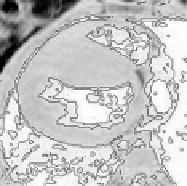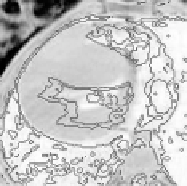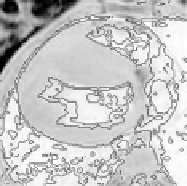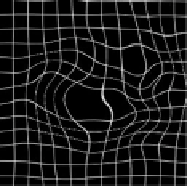Biomedical Engineering Reference
In-Depth Information
(a)
(b)
(c)
(d)
Figure 9.16:
The reference MRI image from a heart sequence with superim-
posed contours (a). The same contours over another image (the test image)
from the same sequence before the registration (b) and after (c). The deforma-
tion field (d). Quadratic splines were used with knot spacing of
h
=
64, image
size was 256
×
256 pixels. (Color slide.)
9.4.11
Summary of Elastic Registration
The algorithm that has been described is a state-of-the-art example of what
is available in the field of fully automatic elastic pixel-based registration. It
contains many features that have been proposed in the literature and it has been
streamlined for an efficient execution.
Elastic registration has numerous applications in the biomedical imaging
field, all based on the basic notion of aligning two images with one other, be
it intersubject, intrasubject, or intermodality. It can be used for motion and
deformation detection. The deformation field itself can be used for deformation
and motion compensation as well as for quantitative measurements.
The criterion, the deformation model, the regularization (penalty), and the
optimization algorithm should be all adapted to the task at hand for optimum
results.
By producing a specialized program taking advantage of a specific config-
uration, the runtime can be probably decreased by an additional factor of 10.




